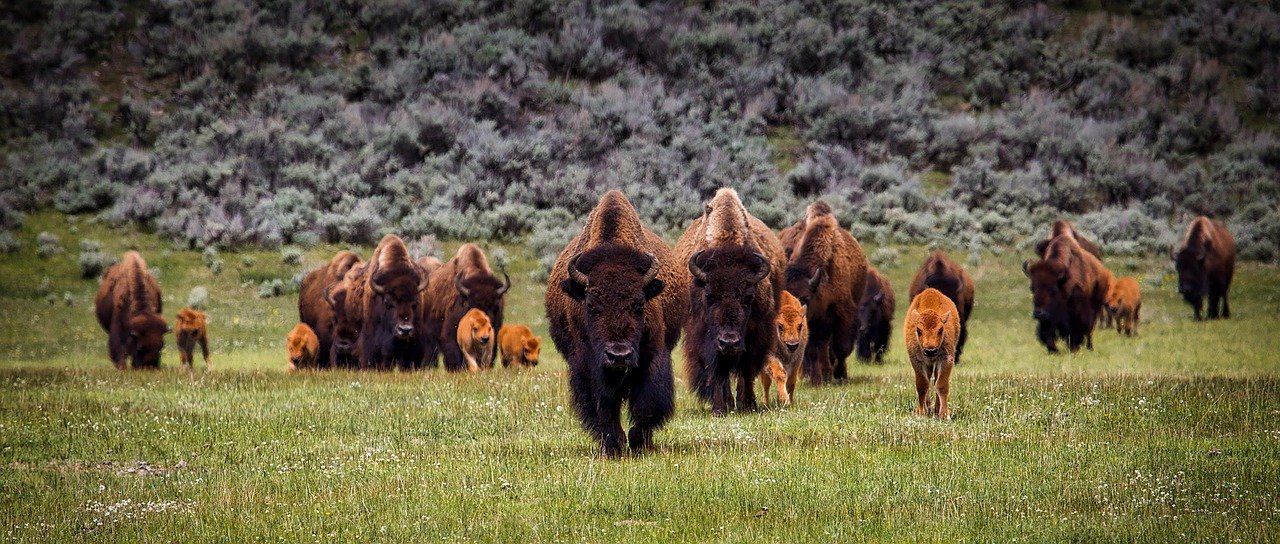The Stoney Nakoda First Nations are combining traditional knowledge with Western science, through the process of "biculturalism," to create a more holistic understanding of the bison reintroduction in Mînî Rhpa Mâkoche, also known as Banff National Park.
In 2017, 16 bison were released in the northeast section of Banff National Park. This herd has since grown to over 60 animals roaming throughout the reintroduction area. Although Parks Canada has been monitoring the ecological impacts of this reintroduction, there has been little to no cultural monitoring data until now. Cultural monitoring can be used to better understand bison herd dynamics, predator-prey relationships, and to better describe the renewed connection to the land by the Stoney Nakoda Nations.
Thanks to an Indigenous-led research collaboration with Mount Royal University and the University of British Columbia funded by the Canadian Mountain Network, the Stoney Nakoda Nations have published this new report on their findings on the Bison Cultural Project. The project was conducted by the Stoney Consultation Team of the Stoney Tribal Administration, along with Stoney Nakoda Elders, knowledge keepers and youth. The report includes recommendations for collaborations between Parks Canada and the Stoney Nakoda to ensure the continued success of the bison reintroduction program, and for cooperative management of the bison herd, ensuring genetic viability, habitat effectiveness, and overall ecosystem health.
The Stoney Nakoda applied their standardized cultural monitoring process, which included ceremony, planning, Elder interviews, fieldwork, Elder reconnection, report writing, and outreach to describe the cultural impacts of the bison reintroduction. William Snow, investigator on this project and Acting Director of Consultation for the Stoney Nakoda Tribal Administration says, “The approach brings together the best of Western science and traditional knowledge to further understanding of what it means for bison to again roam freely in Mînî Rhpa Mâkoche.”
This project is not only providing an understanding of Bison habitat, behaviour and practices, from a traditional knowledge perspective, but is also helping the Stoney Nakoda reconnect to their traditional lands, migration routes, camping sites, and hunting and gathering areas within Mînî Rhpa Mâkoche.
The Stoney Nakoda have been in the Rocky Mountain region since time immemorial and bison were once the centre of the plains landscape ecosystem and central to Indigenous peoples’ lives. Stoney Nakoda subsistence and cultural and spiritual practices were and are still intimately tied to the bison and this landscape. However, due to overexploitation, habitat loss, and disease, bison were nearly extirpated from the Alberta plains. Moreover, when Banff National Park was created, Indigenous people were removed and kept out of the new park in the interest of game conservation for hunting and tourism, and the “civilization” of Indigenous people.
The Bison Cultural Project not only offers traditional knowledge related to bison in mountain landscapes, but also suggests a method for implementing the 11 important report recommendations. In this way, the report is a stepping stone to action, rather than another report on a shelf.
Projects such as this are an integral part of Truth and Reconciliation and demonstrate how traditional ecological knowledge can be woven with Western science to define a more holistic approach to conservation.
This media release was provided by the Canadian Mountain Network.
About the Canadian Mountain Network
The Canadian Mountain Network (CMN) is a national not-for-profit organization that supports the resilience and health of Canada’s mountain peoples and places through research partnerships based on Indigenous and Western ways of knowing that inform decision-making and action.
CMN is funded through the Networks of Centres of Excellence program and is hosted at the University of Alberta.
To learn more about CMN’s research projects visit https://www.canadianmountainnetwork.ca/research/current
Cover image by David Mark.







